Among these is the Tata Group’s establishment of the nation’s first semiconductor production facility at Dholera, Gujarat. It is expected to cost Rs 91,000 crore and would be established in collaboration with the Powerchip Semiconductor Manufacturing Corporation (PSMC) in Taiwan.
Once more, the Tata Group plans to establish an assembly and test plant for semiconductors in Assam at a cost of Rs 27,000 crore. With an investment of Rs 7,600 crore, CG Power, in collaboration with Thailand’s Stars Microelectronics and Japan’s Renesas Electronics Corporation, plans to establish a third semiconductor factory in Sanand, Gujarat.
The application for the manufacturing and testing plant of American memory chip manufacturer Micron Technology in Gujarat was accepted by the government last year. The federal and state governments will generously subsidise all of these. Additionally, a Rs 10,000 crore modernization of the Semiconductor Laboratory (SCL) in Mohali, Punjab, is planned.

Source: The Hindu Business Line
One important area of contemporary industry that relies heavily on money and technology is the semiconductor sector. The supply chains, manufacturing, and distribution of the sector are dominated by a small number of businesses and nations. Technologically sophisticated nations are vying to lead this field because of its strategic significance. Roughly 70% of the world’s chip production capacity is accounted for by China, Taiwan, and South Korea.
The balance is accounted for by the US and Japan. India has started a concerted attempt to increase capacity even though it is not currently listed on any semiconductor fabrication maps. In December 2021, the government unveiled a Rs 76,000-crore incentive package for the manufacturing of chips.
The scheme called for the central and state governments to provide fiscal incentives to proposals in addition to other forms of support. Regarding Micron, the national government bears 50% of the project’s $2.75 billion cost, while the Gujarat government contributes 20%. All segments of the semiconductor sector, including foundries, assembly and testing projects, and packaging units, are eligible for the incentive programs.
Source: First Post
The chips for the automotive, consumer electronics, defence, telecom, power electronics, displays, and other industries will be produced at the authorised plants. For example, the chips produced at the Tata-PSMC plant will mostly have 28 nanometer process nodes, coupled with 50 and 55 nm.
While none of these plants are designed to make GPUs, Al chips, or state-of-the-art compute logic, they are a suitable starting point for the nation’s semiconductor production path and are targeted towards important industries. They will support the integration of Indian industry into international semiconductor supply chains. The nation needs to proceed with semiconductors more quickly and extensively. India needs to increase its already considerable influence in the semiconductor design industry. R&D should also receive a lot of attention.
What do you think about this? Comment below.

